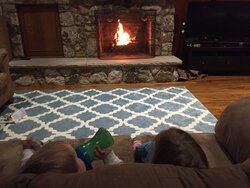Newbie homeowner here and new to fireplaces in general. I'm looking into installing a wood fireplace insert into our den's fireplace. The den is rather large (almost 600 square feet) with 14 foot cathedral ceilings. The room is always cold and it's not something that can be fixed with my current HVAC setup. (I'm sure the 14 ceiling doesn't help).
A friend recommended that get a fireplace insert to heat the room. I've been doing my research online but I still don't quite get how it differs from a regular fireplace. I understand that they are more efficient. But do they light the same way? Do I have have to constantly tend to the fire while its burning? Is it as messy? I was told to expect to spend around $5000.00. Before I take the plunge, I need to know what I'm getting into.
A friend recommended that get a fireplace insert to heat the room. I've been doing my research online but I still don't quite get how it differs from a regular fireplace. I understand that they are more efficient. But do they light the same way? Do I have have to constantly tend to the fire while its burning? Is it as messy? I was told to expect to spend around $5000.00. Before I take the plunge, I need to know what I'm getting into.



 (Me, I love getting a workout and a warm house for free at the same time!)
(Me, I love getting a workout and a warm house for free at the same time!)
